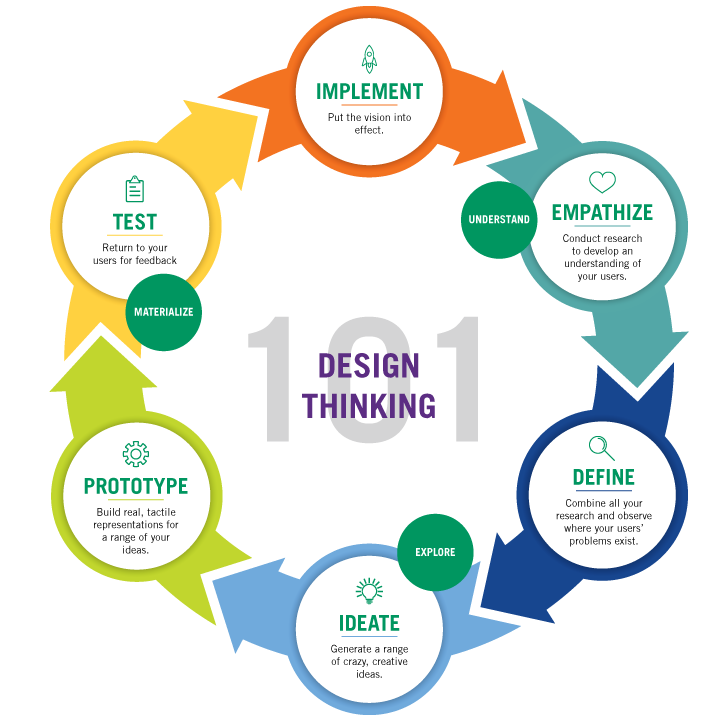Design Thinking Ideation: Solving Modern Business Problems

Companies tend to struggle with organizational disparities between “design thinking” and “business thinking.”
Often, executives “don’t want to get involved in the [creative] process,” said Derrick Kiker, a partner at McKinsey and the CEO of design firm LUNAR, according to Fortune. “Any time you create a chief design officer role and give them a lot of resources, there’s inherently pressure from the executive team. They want to see results almost immediately. And they don’t understand the progression of what has to happen.”
This disconnect exists because many companies are successful due to delivering predictable products by repeatable means. They “almost instinctively resist bringing fuzzy, messy, and abstract visions into the equation,” according to the MIT Sloan Management Review.
Nevertheless, as Fortune observed from more than a dozen top executives and founders at the 2017 Innovation by Design conference, good design is essential for any industry. “This is the great era of design,” said Barry Wacksman, executive president and chief strategy officer for digital agency R/GA.
Design thinking ideation and principles can help businesses stand out from the competition and pursue innovation.
What Is Design Thinking?
Definition
Design thinking is an ideology supported by a process, according to Nielsen Norman Group. Both are necessary to understand design thinking.
The design-thinking ideology asserts that a hands-on, user-centric approach to problem solving can lead to innovation, and innovation can lead to differentiation and a competitive advantage. This hands-on, user-centric approach is defined by the design-thinking process and comprises six distinct phases, as defined and illustrated below.

Stages of the Design Thinking Process
The design thinking process follows an overall flow: understand, explore and materialize. Within these larger buckets, there are six stages of the design thinking process.
1. Empathize
Conduct research to understand what your users do, say, think and feel.
Speak to a range of actual users. What are they doing? How do they think? What do they want? Ask yourself what motivates and discourages them. Gather enough observations to begin empathizing with them and their perspectives.
2. Define
Combine research and observe where your users’ problems exist. As you start pinpointing your users’ needs, begin to highlight opportunities for innovation.
Use data gathered in the empathize stage to gain insights. Organize your observations and look at similarities to your users’ current experiences. Are there common pain points? Identify any unmet user needs.
3. Ideate
Brainstorm all types of crazy, creative ideas that address unmet user needs from the define phase. Stress quantity; no idea is too farfetched.
Bring your team members together and present many ideas. Have team members share ideas with one another, and look to combine and re-combine different ideas.
4. Prototype
Create actual representations for a subset of your ideas. The goal of this phase is to understand what components work and do not work. This is the phase where you begin to look at the impact vs. feasibility of your idea through feedback on your prototypes.
It’s important to make your ideas tactile. If the idea is a new website, develop a mockup of the website. Make changes based on feedback you receive and then create a new prototype. Then you can share it with a new group of people to obtain more feedback.
5. Test
Return to your users for feedback. Gauge whether your solution will meet their needs and if it has improved how they feel, think or do their tasks.
Verify this by putting it in front of real customers. Determine whether their perspectives have changed and if the new solution will meet organizational goals (such as profitability or time on site for a new website). Continue to test as you execute your vision.
6. Implement
Put the vision into effect. Ensure that it will impact your end users.
“This is the most important part of design thinking, but it is the one most often forgotten,” according to Nielsen Norman Group. This can be a long and difficult process, but it is essential to reap the benefits of design thinking iteration. “As impactful as design thinking can be for an organization, it only leads to true innovation if the vision is executed. The success of design thinking lies in its ability to transform an aspect of the end user’s life. This sixth step — implement — is crucial.”
How to Take Advantage of Design Thinking Ideation
Research from MIT Sloan Management Review resulted in five steps that can take full advantage of the potential of design thinking.
- Encourage top managers to champion design thinking initiatives. Managers are spread too thin, yet design thinking teams require two kinds of attention by top management: proactive and follow-up. Proactive attention includes many forms like launching an initiative, taking part in the design thinking process, developing and submitting ideas and removing obstacles. Follow-up attention refers to energy the leader invests after the design thinking team does its work, like pushing ideas through the organization.
- Balance the teams. It can be difficult to allow people freedom while ensuring they don’t lose focus on other business objectives. One key is recognizing and appreciating the diversity of their experience and skills. Some members should focus on certain aspects of the process.
- Set ground rules. Design thinking teams should be empowered to work without getting permission for every step. Minimal rules can help reinforce the autonomy they need to function well.
- Integrate design thinking into product-development processes. “Design thinking is often treated as yet another assignment from headquarters — just one more box to be checked,” according to MIT Sloan Management Review. “To change that perception, the teams responsible for design thinking should look more closely at their existing product-development processes. It can be helpful to integrate specific design thinking deliverables, such as early customer feedback in the problem-definition phase, larger-scale customer feedback in the market-solution phase, and prototypes and mock-ups throughout the process.”
- Redefine the metrics. Design thinking teams should not focus on profit, but on learning. This is captured through defined learning outcomes and questions. Even if the overall project fails, insights will be gained through learning, which can then be applied to better questions or another project.
Pursuing a Career in Business
Understanding design thinking ideation can stimulate creativity and innovation in business. An online bachelor’s in business administration, online applied business degree or online MBA from Concordia University Texas can give you the skills to succeed in helping organizations thrive. Learn in a flexible, convenient online environment with a schedule that fits your life.
